| 1 |
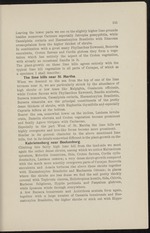 |
“...Caesalpinia coriaria, Haematoxylon Brasiletto,
Bursera simaruba are the principal constituents of the pretty
dense thickets of shrubs, with Euphorbia thymifolia and especially
Capraria biflora at the bottom. .
Nearer the sea, somewhat lower on the incline, Lantana mvolu-
crata, Bumelia obovata and Croton vegetation become prominent
and finally Agave vivipara with Cactaceae.
Especially in the part West of St. Martha the lime hills are
highly overgrown and treelike forms become more prominent.
Similar in its general character to the above mentioned lime
hills, but in its details somewhat different is the plant-growth on e
Kabrietenberg near Beekenburg.
Climbing this fairly high lime hill from-the land-side we meet
again the rather dense shrubs, among which we notice Malvastrum
spicatum, Melochia tomentosa, Sida, Croton flavens, Cordia cylm-
drostachya, Lantana camara; a very dense shrub-growth compared
with the much more scantily overgrown parts of Curasao. Beurena
succulenta and Acacia tortuosa...”
|
|
| 2 |
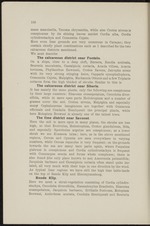 |
“...plant combinations such as I described for the two
calcareous districts mentioned.
We next describe
The calcareous district near Fontein.
On a slope, close to a deep cleft, Bursera, Randia aculeata,
Beureria succulenta, Caesalpinia coriaria, Acacia villosa, Acacia
tortuosa, Phyllanthus Euwensii, Croton flavens, Jatropha urens
with its very strong stinging hairs, Capparis cynophallophora,
Crescentia Cujete, Malpighia, Machaonia Ottonis and a few Triplaris
coriacea form the high thicket of shrubs. Similar to this is
The calcareous district near Siberie.
It has mainly the same plants, only the following are conspicuous
by their large numbers: Rhacoma crossopetalum, Coccoloba diver-
sifolia, while in more open parts Heliotropium and a number of
grasses coyer the soil. Croton niveus, Malpighia and especially
many Cephalocereus lanuginosus are- together with Guaiacum
officinale and Condalia Henriquezii the principal plants, while
here Metopium Brownei is already one of the tallest trees.
The lime...”
|
|
| 3 |
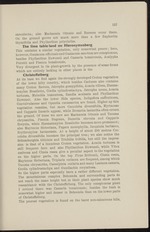 |
“...157
succulenta; also Machaonia Ottonis and Bursera occur there.
On the ground grows not much more than a few Euphorbia
thymifolia and Phyllanthus polycladus.
The lime table land on Hieronymusberg.
This contains a similar vegetation, only somewhat poorer; here,
however, Guaiacum officinale and Guaiacum sanctum are conspicuous,
besides Phyllanthus Euwensii and Casearia bonairensis, Acalypha
Poiretii and Pisonia bonairensis.
Very divergent in its plant-growth by the presence of some forms
which are entirely lacking in other places is the
Christoffelberg. _ .
At its base we find again the strongly developed Croton vegetation
of the lower hilly country, which besides Cactuses also contains
many Croton flavens, Jatropha gossypifolia, Acacia villosa, Haema-
toxylon Brasilettq* Cordia cylindrostachya, Jatropha urens, Acacia
tortuosa, Melochia tomentosa, Randia aculeata and Phyllanthus
Euwensii. Also the lower Sida species, Indigofera suffrutieosa,
Convolvulaceae and Opuntia curassavica are found...”
|
|
| 4 |
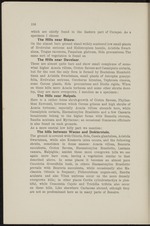 |
“... Guaiacum officinale
is also found on such grounds.
As a more central low hilly part we mention:
The hills between Wacao and Dokterstuin.
The ground is covered with Chloris, Sida, Cassia gland ulosa, Aristida
Swartziana, while also Krameria ixina occurs, and the following
shrubs, sometimes in dense masses: Acacia villosa, Beureria
succulenta, Croton flavens, Haematoxylon Brasiletto, Lantana
camara, Malpighia; amidst these more overgrown hills we see
again more bare ones, having a vegetation similar to that
described above. In some places it becomes an almost pure
Cöccoloba diversifolia bush, in others Haematoxylon Brasiletto
prevails with Beureria succulenta, while occasionally also Ma-
chaonia Ottonis is frequent; Pithecolobum unguis-cati, Randia
aculeata and also Yitex umbrosa occur on the more densely
overgrown hills; in other places Cordia cylindrostachya is plen-
tiful, while Crescentia Cujete and Trichilia trifolia also occur
on these hills. Like elsewhere Cactaceae abound, athough...”
|
|
| 5 |
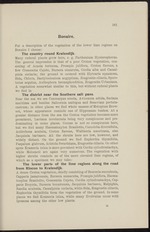 |
“...round Kralendijk.
Many ruderal plants grow here, e. g. Parthenium Hysterophorus.
The general impression is that of a poor Croton vegetation, con-
sisting of Acacia tortuosa, Prosopis juliflora, Croton flavens, a
few Crescentia Cujete, Bursera simaruba, Cordia alba and Caesal-
pinia coriaria; the ground is covered with Elytraria squamosa,
Sida, Chloris, Dactyloctenium aegyptium, Eragrostis ciliaris, Sporo-
bolus argutus, Anthephora hermaphroditica, Eragrostis Urbaniana.
A vegetation somewhat similar to this, but without ruderal plants
we find in
The district near the Southern salt pans.
Near the sea we see Conocarpus erecta, Avicennia nitida, Suriana
maritima and besides Salicornia ambigua and Sesuvium portula-
castrum; in other , places we find whole masses of Metopium Brow-
nei, whose appearance reminds one of Hippomane bushes. At a
greater distance from the sea the Croton vegetation becomes more
prominent, Lantana involucrata being very conspicuous and pre-
dominating in some places....”
|
|
| 6 |
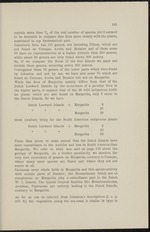 |
“...found and where they are not
scarce at all.
Cactaceae cover whole fields in Margarita and this agrees entirely
with certain parts of Bonaire; the Bromeliaceae which are so
conspicuous on Margarita play a subordinate part in the Dutch
W. I. Islands. The typical tropical families like Melastomataceae,
Aroideae, Piperaceae are entirely lacking in the Dutch Islands,
contrary to Margarita.
As far as can be inferred from Johnston’s descriptions (1. c. p.
278 ff.) the vegetation along the sea-coast is similar in type to...”
|
|
| 7 |
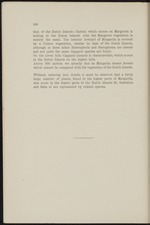 |
“...166
that of the Dutch Islands; Castela which occurs on Margarita is
lacking in the Dutch Islands. Also the Mangrove vegetation is
mainly the same. The interior lowland of Margarita is covered
by a Croton vegetation, similar to that of the Dutch Islands,
although in these latter Heteropteris and Sterophoma are absent
and not quite the same Capparis species are found.
On the lower hills Capparis linearis is characteristic, which occurs
in the Dutch Islands on the higher hills.
Above 300 metres we alraedy find on Margarita denser forests
which cannot be compared with the vegetation of the Dutch Islands.
Without entering into details it must be observed that a fairly
large number of plants, found in the higher parts of Margarita,
also occur in the higher parts of the Dutch Islands St. Eustatius
and Saba or are represented by related species....”
|
|
